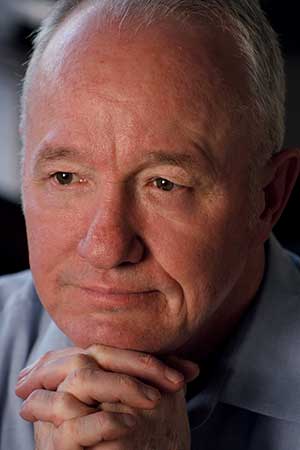OPINION by John Sheridan, Digital Business insights >>
FORMER TREASURY BOSS Ken Henry said, “something is desperately wrong” with Australia’s economy, which is beset by “structural deficiencies” that cannot be fixed by interest rate cuts or government largesse.
Dr Henry argued the main reason productivity was declining was a lack of business investment in new technology and equipment that increased the efficiency of the workforce.
“Business investment today as a proportion of gross domestic product is almost as low as it was in the depths of the early-90s recession,” Dr Henry said.
“The reason why Australia celebrates a current account surplus today is because business investment is so weak. We should not be celebrating this. This is sending us a signal that there is something desperately wrong in Australia.”
Something is desperately wrong in Australia. 
Not enough investment in new technology. Software, robotics, automation, AI. The tools that extend ‘arm, eye and brain power’ to help us achieve more.
It’s not about people working harder or longer, it’s about people working smarter using the 21st century tools we now have, with them focused on our productive industries.
Our productive industries
Our productive industries are: manufacturing, agriculture, smart trades, mining, professional services, ICT, creative industries, education, media and communications.
Most of the other industry sectors are service and support industries for our productive industries. They help and catalyse the production of goods and services. But they don’t make them.
Of the 13.5 million Australian workforce, our productive industries represent roughly 4.5 million workers across eight industry sectors. These are the industries that generate wealth and exports, providing a platform for future prosperity.
The demand for more ‘productivity’ is regularly delivered by the Business Council of Australia and a variety of business spokespeople, and used to criticise the Australian workforce as a whole, claiming they need to be more productive to justify wage increases.
But statements like these do little to advance solutions to the issues Ken Henry rightly outlines.
There are two things to consider.
One is the lack of business investment in new technology. And the other more nuanced issue stems from what productivity is, how it is measured and what it means in today’s digital economy where well over half the working population is not involved in the production of wealth creating goods and services anyway.
We don’t live in the 19th century any more. We don’t all work in factories, mills, farms and building sites making things to be bought and sold.
Few of us write books, plays, films and software, paint, design and create.
Most of us don’t dig holes in the ground or drill for oil and gas.
What the majority of us do is service and support workers in productive industries as best we can.
Productivity shouldn’t be the only goal
In many cases, increased productivity can be viewed as counter-productive.
How do we make teachers more productive? Bigger classes?
How do we make musicians more productive? Bigger audiences?
How do we make politicians more productive? Longer speeches?
How do we make nurses more productive? More patients?
Doing more isn’t always a good thing.
According to the Productivity Commission, “Productivity is a measure of the rate at which output of goods and services are produced per unit of input (labour, capital, raw materials, etc.)
“Productivity is a measure of the efficiency of a person, machine, factory, system etc., in converting inputs into useful outputs.”
A useful definition for the industrial revolution. Not so useful now.
The ABS calculates productivity using a measure of output called gross value added, which is the value of the output produced by the firm minus the intermediate inputs used (materials, services and energy used in production).
But what factors do you include in your multivariate data analysis that make real sense today?
What is ‘labour productivity’ in the middle of a digital revolution when many tasks and even job roles are fulfilled by software and technology in its many forms.
While we continue to accept these definitions as ‘truths’ we will continue to suffer the impacts of the malaise Ken Henry rightly outlines.
Work harder and you will get more pay
The intrusion of software into every aspect of our economy makes nonsense of the measure of input.
Estimates of productivity are increasingly pure guesses from the ranks of ‘economists’ cloistered within a variety of government institutions. Emperor’s new clothes.
How does anybody credibly measure the impact of software on our economy, given its multi-national, interconnected and integrated role not just in single organisations but across sectors and supply chains, and its role in information exchange between organisations of all kinds?
Software increases efficiency. It also automates many activities, processes and functions that historically were performed by a person and measured by hours worked and outputs per hour.
And once you add the automation of physical tasks and the management and control of machinery through software and robotics, the issue of measurement becomes more confused.
Inputs and outputs can be measured, but what role does a person play in that equation to be rewarded for increased productivity by employers? In fact, removing the person makes measurement easier.
Add the automation of software (artificial intelligence, AI) into the mix and we will diminish the role a person plays in outputs even further.
Where does the work take place in an increasingly interconnected and integrated world?
In the data centre? On the device? What is the input? Where is the output? Ask the tax office. They don’t know either.
Where do we deliver the increase in wages for increased productivity? To the robot? To the AI? To the software developer? To Google? To Microsoft? To Amazon?
This conundrum will become even more complicated over the next decade and beyond.
We lack the tools to measure what is happening. We lack the means to understand it. Or control and manage it. Which is a problem. Who is ‘steering the ship of state?’
It is the 21st century not the 20th any more, and our thinking needs to match the changes imposed by the digital revolution not lag light years behind.
Government always lags technological change. And the government organisations that should be serving our interests, aren’t. And can’t.
It is not their fault. That is just the way it has always been.
The Productivity Commission. Jobs and Skills Australia. The ABS. And all departments of industry and development. They follow technology developments. They don’t and can’t lead.
By default, direction for government is offered by ‘big tech’ and consultants of many flavours. It’s one of the reasons government spending on consultants has gone through the roof.
Single business productivity growth
For single businesses it is an easier proposition.
For single businesses, productivity growth is important because providing more goods and services to customers translates to higher profits. As productivity increases, an organisation can turn resources into revenues, paying stakeholders and retaining cash flows for future growth and expansion.
The result of adding more software into the business mix can be measured. But as technology is incorporated, allocating reward becomes more difficult.
Is it the person or the software? Does it matter?
In the crudest way, we know that bringing more technology and software into a business reduces bottom line costs – wages. Organisations can be leaner and meaner. Even smarter and more strategic.
Productivity is important. But it is not the key factor in most industry sectors.
Productivity in different industry sectors means different things.
At the macro level we have 19 industry sectors divided into hundreds of individual business categories, many with unique characteristics. Cane farmers are not like high school teachers. Lawyers are not like fabricated steel manufacturers. General practitioners are not like real estate agents. They do different things, in different ways, using different tools.
And their outputs and performance are measured differently as well. Or should be.
More than half of our industry sectors are not productive industries.
In broad terms we have primary industries, secondary, tertiary and quaternary.
Primary industries include agriculture, forestry, fishing and mining.
Secondary or manufacturing industry plus energy and construction.
Tertiary includes the service industries of finance, real estate, wholesale, retail, transport, professional services, accommodation and catering, entertainment, repair, health, administration and defence.
Quaternary includes ICT, research and education.
We can group these industry sectors into those that produce a product or service and those that service and support the industries producing a product or service.
We dig up minerals and drill for oil and gas – then sell them. Automation and software have improved productivity in mining enormously and continue to do so.
We grow plants and animals and sell them as raw or processed goods. Automation and software are improving productivity in agriculture offsetting many limitations on supply of farm workers.
We manufacture a range of products and sell them domestically and overseas. Automation and software continue to drive improvements.
We sell professional services overseas. Engineering, architecture, design and other services increasingly driven by software.
We provide education for students from overseas with online learning becoming ubiquitous due to COVID, learning management software and videoconferencing.
These activities all generate wealth for Australia. We can add value and improve the outputs through innovation, design, branding and advertising to increase price and support jobs.
And many of the service industries support these activities directly or indirectly.
New technology, equipment, design, branding and advertising can help create new products and services and open up new markets through export.
Producing productively, servicing effectively
Productive industries are productive.
But our service and support industries don’t offer the same opportunities. And they should not be considered or measured in the same way.
In many service industries we don’t want workers to be more productive – nurses, firemen, police, defence personnel, aged care and childcare workers etc. We want them to be effective, which is not usually a function of efficiency, speed or output.
The value is measured in other ways, and not always in a spreadsheet – satisfaction, happiness, health, safety, smiles, understanding, reassurance, sharing of experience, legislation, regulation.
The support industries – public administration, retail, accommodation and food, administrative services, transport, wholesale, personal services, finance, rental and real estate and utilities – support productive industries.
Over a million people work in the retail sector and productivity is not the key issue. Customer acquisition is, and software has made that process more efficient, with COVID driving online sales and out of store delivery creating a retail environment where productivity is all due to software.
Same with wholesale, with Amazon leading the way in automating the role of humans in warehouses to the optimal extent, before moving totally into robotics.
Workplace health and safety, road safety and traffic rules are the only constraints to more productivity in transport operations. The ‘holy grail’ of fully automated transport delivery is still an idea, but inevitable.
And the same for the other services industries, where productivity only delivers limited benefits within the organisation and is often meaningless to the world outside.
Services are there to support productive industry. New technology and equipment can increase efficiency and profit to productive industries, and help support industries deliver more effective support to the wealth generators in the economy – the productive industry sectors.
We need efficiency in both. But not necessarily productivity.
Increasing productivity in our productive industries offers the biggest economic benefit to Australia.
It can and will lead to greater diversification in our economy and steadily diminish our over-reliance on mining, food, education and tourism.
These sectors are very important and will remain important for a long time. But we can’t afford to have all our eggs in one basket. We need more baskets (markets) and more eggs (products and services). Australia lacks economic complexity.
At the moment, we are too reliant on one basket (China) and two big eggs (mining and education). Diversification diminishes risk.
The support industries are there to support the productive industries.
But our productive industries need to grow. And that won’t happen on its own.
Mining is productive backbone of Australia
At the moment mining is the backbone of the Australian economy and has been for years.
Mining produces royalties. Mining encourages development of new technology. Mining leads the way in robotics development and AI.
But we now need to leverage the intellectual horsepower of CSIRO, Data61 and our 38 research-based universities and apply that creative energy of ideas and experimentation across the whole spectrum of our productive industries.
Not just to support the miners and mining related manufacturers, but to generate new productive industries of our own. OEMs. Original equipment manufacturers.
For our productive industries are where we can generate opportunity with new products and services, diversify our economy, expand our overseas markets and create a more resilient foundation for Australia’s future. For our kids and grandkids.
We have generated deep knowledge from the mining industry, which can be applied elsewhere – water, pollution control, safety, waste management, space, recycling, robotics, off road vehicle automation, energy, remote control systems, AI and drones.
Much of this knowledge is valuable in countries facing similar issues to us. Especially issues with energy, water, pollution, environment, safety and remote-control systems = Export.
And we can apply that same intellectual horsepower to other industries – assistive technology, disability services, aged care, energy, waste management, soil health, aquaculture, housing, preventative medicine, manufacturing, sport and recreation = More Export.
Universities must get down to business
However, we need to connect our universities to business in a more effective and impactful way.
The lack of synchronisation between business and academia in Australia is criminal.
Universities are funded, measured and rewarded for teaching and publishing, but not for engagement with industry. The funding model for industry engagement is clumsy and frugal. Government has made it hard, not easy, for universities to engage. Universities should be rewarded for helping to create a more diversified economy.
Some universities have made a point of engaging with local business anyway.
And the benefits are obvious. Students gain experience of engaging with real business problems and possible job offers. Business owners gain new insight, perspectives and ideas.
Applied systematically and universally, this approach could turbo charge the whole spectrum of productive industries in Australia. Not just in the capital cities, but in areas surrounding regional universities, and in rural and remote areas through online webinars and conferencing.
We have all the pieces to the big picture. They have just never been assembled in the right order.
Innovation in our productive industries is where our future should be built.
In energy, waste management, pollution control, water, automation and robotics, arts and crafts, fashion, manufacturing, ICT, education, space, mining services, defence, assistive technology and ag-tech.
These are industries that will help us manage climate change. These are the industries that will deliver high reward jobs and employment opportunities.
These are the industries that will provide products and services that can be exported to the world.
In 2023.
And 2023 is here.
Time to put the pieces together and turn the big picture into reality.
www.redtoolbox.org
About the author
John Sheridan is the CEO at Digital Business insights, the company behind the creation of the Regional Economic Development (RED) Toolbox. The RED Toolbox has been steadily developed over the past 10 years to provide a collaboration platform for Australian economic development, including a range of showcases that promote national and international trade opportunities and connections.
ends


 How to resolve AdBlock issue?
How to resolve AdBlock issue? 





